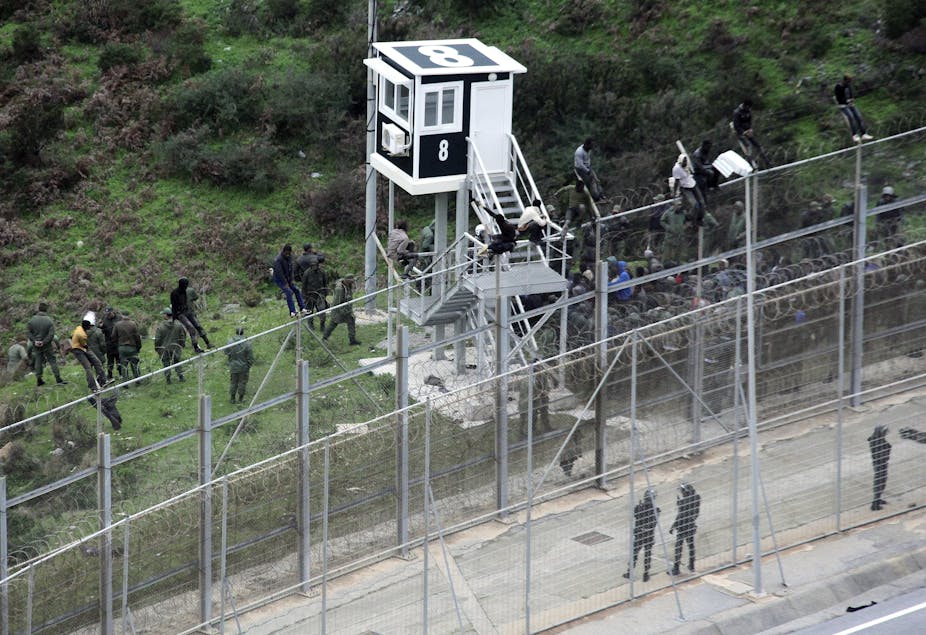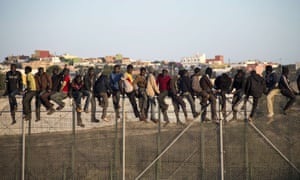 |
| Image from: http://theconversation.com/ceuta-and-melilla-the-spanish-enclaves-at-the-centre-of-the-fight-against-terrorism-83196 |
The Ceuta and Melilla border fences form part of the frontier between Morocco and Spain in the towns of Ceuta and Melilla. Both represent a long history of the Spanish-Moroccan interactions. Such towns are two of Northern Morocco's most important Spanish-controlled enclaves after the end of "Reconquista". Melilla was first conquered by Spain in 1497 and Ceuta, which was captured first by Portugal, was returned to Spain under the Lisbon Treaty in 1668 (Saddiki, 2017). Both cities were important port cities, offering protection to Spanish ships and serving as European-American trading posts. When Morocco held independence, Spain refused to handover Ceuta and Melilla. ('Ceuta and Melilla: Why does Spain own two cities in Africa?', 2018).
The Spanish government is using the illegal immigration issue as an excuse to reinforce the fences. There was a significant change in these territories in 1993 when the perimeters, which was once surrounded by high and thick stone walls to protect and defend against threats and external attack of all kinds, started to be marked by fences. The construction of a more secure system began in the autumn of 1995 with the use of advanced technologies, such as infrared cameras. In 2005, the third fence was built by the Spanish government next to the two degraded ones already in place to fully seal the border from infiltration apart from the designated checkpoints (Saddiki, 2017).
Spain's purpose is to prevent illegal migration and smuggling, but this has caused a massive impact not only to the country, but also to the relationship of each citizen. Both citizens of Melilla and Ceuta may be living the life as part of the Spanish cities with Spain's architectural style and Spanish-speaking people and paying in Euro currency. But, could only be seen unless you crossover the high fences these two towns.
 |
| Image from: https://www.nytimes.com/2018/08/19/world/africa/ceuta-morocco-spain-migration-crisis.html |
Outside these borders are a large amount of immigrants who wish to crossover these fences. The International Organization of Migration had recorded 1, 419 migrants who had crossed over to Spain. There is also another way of crossing over, through the West Mediterranean Sea, but this is more dangerous. Throughout June of 2018, 294 migrants drowned in reaching over to Spain. There, as they reach over, they can move over to an asylum that could take months in applying (Nordland, 2018).
 |
| Image from: https://www.theguardian.com/cities/2017/may/10/melilla-refugees-spain-africa-gateway-europe |
Wishing to have a better life, they try to migrate, but these ways had already brought danger to their lives. Cases of abuse and lack of legal assistance in centers, in Melilla, have been reported. It has also been reported, more or less, seventy menas, term for unaccompanied foreign minor, were living without a home, most of them in the streets (Bausells, 2017).
 |
| Image from: https://www.moroccoworldnews.com/2019/12/288197/spain-fences-ceuta-melilla-borders/ |
By these incidents, Spain had already planned to improvise more strongly built and guarded fences. Spain will be removing these barbed wires, as it is termed as dangerous and ineffective way of recording illegal migration, and will be replacing them into a more secured and monitored fences (Guessous, 2019).
Morocco also helps Spain in guarding these illegal migrants from crossing. Migrants have already built campsites near the borders for an easy access, but the Moroccan authorities are on watch in these camps. They have start raiding these camps, destroying properties and violently harassing women ('Europe's most fortified border is in Africa', 2017).
"Good fences make great neighbors"
Ceuta and Melilla border fences would never be categorized as good fences. As mentioned above, thousands of authorities are on their watch to make the border stand as a stop for illegal migrants. Even the Moroccan authorities go against their citizens just to stop this issue ('Europe's most fortified border is in Africa', 2017). In connection, Spain is already planning to modernize and build more secured fences (Guessous, 2019).
In terms of protection once you reach over, you are treated as badly as you crossed over. Making you live in streets(Bausells, 2017) and letting you drown and get killed even when crossing over (Nordland, 2018). You can just enjoy the life you want in Spain if you are able to survive in these failures.
Mending Wall
The Mending Wall's message, by Robert Frost, is almost as the same as the situation in Ceuta and Melilla. In Mending Wall, neighbors keep on building walls to stand as a barricade. The 'neighbor' is depicted as Spain as it keeps building walls while 'I' is depicted as the migrants as it wants to enter into the world of the 'neighbor' ("What is the theme of the poem "Mending Wall"?", 2008).
Spain keeps on building these barbed wire fences to prevent them, even modernizing them to implement the rule of no illegal migration. The migrants wants to try and try again even if they fail many times, just to live the life they wanted in Spain despite of the harsh journey they've gone through.
References:
Saddiki, S. 2017.3. The Fences of Ceuta and Melilla. In World of Walls: The Structure, Roles and Effectiveness of Separation Barriers. Open Book Publishers. Retrieved from: https://books.openedition.org/obp/4562?lang=en
"Ceuta and Melilla: why do Spain own two cities in Africa?". 2018. The Week. Retrieved from: https://www.theweek.co.uk/94326/ceuta-and-melilla-why-does-spain-own-two-cities-in-africa
Rod Nordland. 2018. "'All of Africa is here': Where Europe's Southern Border is Just a Fence". The New York Times. Retrieved from: https://www.nytimes.com/2018/08/19/world/africa/ceuta-morocco-spain-migration-crisis.html
Rod Nordland. 2018. "'All of Africa is here': Where Europe's Southern Border is Just a Fence". The New York Times. Retrieved from: https://www.nytimes.com/2018/08/19/world/africa/ceuta-morocco-spain-migration-crisis.html
Marta Bausells. 2017. "In limbo in Melilla: The young refugees trapped in Spain's African enclave". The Guardian. Retrieved from: https://www.theguardian.com/cities/2017/may/10/melilla-refugees-spain-africa-gateway-europe
Hamza Guessous. 2019. "Spain Modernizes Security Fences at Ceuta, Melilla Borders". Morocco World News. Retrieved from: https://www.moroccoworldnews.com/2019/12/288197/spain-fences-ceuta-melilla-borders/
"Europe's most fortified border is Africa". 2017. Vox. Retrieved from: https://www.youtube.com/watch?v=LY_Yiu2U2Ts&t=442s
"What is the theme of the poem "Mending Wall"?". 2008. eNotes Editorial. Retrieved from: https://www.enotes.com/homework-help/what-theme-poem-mending-wall-20711
If you could consider a better font style and color for easy reading... would really help a lot..
ReplyDelete